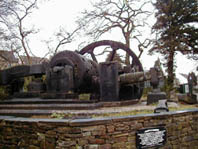Thus spinning by machinery made weaving by machinery a necessity, and both together made the mechanical and chemical revolution that took place in bleaching, printing, and dyeing, imperative. So too, on the other hand, the revolution in cotton-spinning called forth the invention of the gin, for separating the seeds from the cotton fibre; it was only by means of this invention, that the production of cotton became possible on the enormous scale at present required. But more especially, the revolution in the modes of production of industry and agriculture made necessary a revolution in the general conditions of the social process of production, i.e., in the means of communication and of transport. In a society whose pivot, to use an expression of Fourier, was agricultureon a small scale, with its subsidiary domestic industries, and the urban handicrafts, the means of communication and transport were so utterly inadequate to the productive requirements of the manufacturing period, with its extended division of social labour, its concentration of the instruments of labour, and of the workmen, and its colonial markets, that they became in fact revolutionised. In the same way the means of communication and transport handed down from the manufacturing period soon became unbearable trammels on Modern Industry, with its feverish haste of production, its enormous extent, its constant flinging of capital and labour from one sphere of production into another, and its newly-created connexions with the markets of the whole world. Hence, apart from the radical changes introduced in the construction of sailing vessels, the means of communication and transport became gradually adapted to the modes of production of mechanical industry, by the creation of a system of river steamers, railways, ocean steamers, and telegraphs. But the huge masses of iron that had now to be forged, to be welded, to be cut, to be bored, and to be shaped, demanded, on their part, cyclopean machines, for the construction of which the methods of the manufacturing period were utterly inadequate.Modern Industry had therefore itself to take in hand the machine, its characteristic instrument of production, and to construct machines by machines. It was not till it did this, that it built up for itself a fitting technical foundation, and stood on its own feet. Machinery, simultaneously with the increasing use of it, in the first decades of this century, appropriated, by degrees, the fabrication of machines proper. But it was only during the decade preceding 1866, that the construction of railways and ocean steamers on a stupendous scale called into existence the cyclopean machines now employed in the construction of prime movers.The most essential condition to the production of machines by machines was a prime mover capable of exerting any amount of force, and yet under perfect control. Such a condition was already supplied by the steam-engine. But at the same time it was necessary to produce the geometrically accurate straight lines, planes, circles, cylinders, cones, and spheres, required in the detail parts of the machines. This problem Henry Maudsley solved in the first decade of this century by the invention of the slide rest, a tool that was soon made automatic, and in a modified form was applied to other constructive machines besides the lathe, for which it was originally intended. This mechanical appliance replaces, not some particular tool, but the hand itself, which produces a given form by holding and guiding the cutting tool along the iron or other material operated upon. Thus it became possible to produce the forms of the individual parts of machinery“with a degree of ease, accuracy, and speed, that no accumulated experience of the hand of the most skilled workman could give.”
If we now fix our attention on that portion of the machinery employed in the construction of machines, which constitutes the operating tool, we find the manual implements re-appearing, but on a cyclopean scale. The operating part of the boring machine is an immense drill driven by a steam-engine; without this machine, on the other hand, the cylinders of large steam-engines and of hydraulic presses could not be made. The mechanical lathe is only a cyclopean reproduction of the ordinary foot-lathe; the planing machine, an iron carpenter, that works on iron with the same tools that the human carpenter employs on wood; the instrument that, on the London wharves, cuts the veneers, is a gigantic razor; the tool of the shearing machine, which shears iron as easily as a tailor’s scissors cut cloth, is a monster pair of scissors; and the steam-hammer works with an ordinary hammer head, but of such a weight that not Thor himself could wield it. These steam-hammers are an invention of Nasmyth, and there is one that weighs over 6 tons and strikes with a vertical fall of 7 feet, on an anvil weighing 36 tons. It is mere child’s-play for it to crush a block of granite into powder, yet it is no less capable of driving, with a succession of light taps, a nail into a piece of soft wood.
Karl Marx (The capital)
